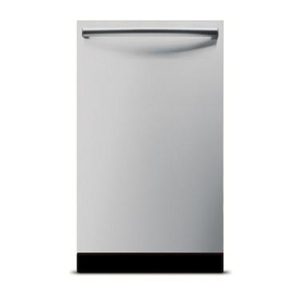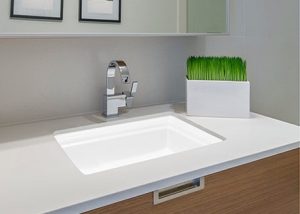Water
Displaying 1 - 1 of 0 Articles
Categories
-
July 14, 2017
Dishwashing Tips for Cleaner Dishes
Three tips for cleaner dishesTry these tips for cleaner dishes, or get a new dishwasher at UAKC Here are three suggestions to make sure you're getting the most out of your dishwasher:1. Don't pre-clean your dishes.Some people want to give their dishwasher a little help by pre-washing their dishes. While you certainly don't want to put your leftover for baked on food in your dishwasher, it is not a good idea to rinse off your dishes before placing them in the dishwasher. Dishwasher detergents contain chemicals that keep food particles removed from the dishes in suspension so that they don't get redeposited on your dishes. If you put only clean dishes in the dishwasher, the detergent will find no dirt particles and wind up as a film on your already clean dishes.2. Hot water gets dishes clean.Typically, dishwashers will heat incoming water to 150 degrees or more depending on the cycle selected. However, the incoming water needs to be 120 degrees for this to happen. Even if your water heater provides water at 120 degrees, if your dishwasher is located too far from the water heater, the hot water may not be hot enough by the time it gets to the dishwasher. My water heater is at one corner of my house, and my dishwasher is clear over at the other corner, as far as it can be from the water heater. We need to run the hot water at the sink near the dishwasher for a few minutes before we
-
June 24, 2017
Refrigerators with Ice Makers
New Refrigerators with Ice MakersGreat Selection at Universal Appliance and Kitchen CenterLooking for a new refrigerator? Bet you're going to want a built-in ice maker. An overwhelming percentage of refrigerator buyers select a refrigerator with an automatic ice maker. Most new homes today have a water line plumbed in the wall right behind the refrigerator space so why not?Here are a few things to think about when you decide on ice maker equipped refrigerators: Of course, as mentioned above, do you have a water line to connect your refrigerator so it can produce ice? If not, then you will need to connect to a water line and extend a water supply to the back of your refrigerator. Dispenser or no dispenser. It's very common to have a water and ice dispenser in the door, but there are other options. For example, you may choose a refrigerator which has no water dispenser at all, but is equipped with an ice maker only. In fact, many very expensive built-in refrigerators are non-dispenser models for esthetic reasons yet they typically will have an ice maker in the freezer. One or Two Ice makers. Yes, some refrigerators have two ice makers. Think of an ice maker and dispenser built right into the door, and a second ice maker in the bottom freezer compartment. You will need a replaceable water filter. Typically, these are built-in and last for 6 months or so. Your refrigerator will come equipped with one.Here's an example of a deluxe two
-
September 20, 2015
Get up to $7K in Wolf Gourmet products with Purchase
Purchase Sub-Zero and Wolf appliance packageGet up to $7000 of Wolf Gourmet ProductsTime to buy new appliances? Consider Sub-Zero and Wolf. They set the standard for luxury appliances, and now you can get up to $7000 of Wolf Gourmet products with your purchase. The new Wolf Gourmet Collection includes countertop appliances, cutlery, and cookware to complete your new kitchen. Here's the exciting new Wolf Gourmet Countertop Oven: When it comes to Sub-Zero, well, they pretty much invented the built-in refrigerator for the home. And ever since, they've been improving and perfercting what already seemed perfect. Here's how Sub-Zero describes this popular model: Sub-Zero 42" Built-In Side-by-Side Refrigerator FreezerWrinkled fruit, wilted lettuce. You’ve seen your share of past due, even spoiled food in the refrigerator. Well, it doesn’t have to be that way – the Sub-Zero 42” Built-in Side-by-Side Refrigerator keeps your food fresher longer with the most advanced food preservation technology available - a technology developed through almost 70 years of research. That means crisper greens, juicier peppers, blueberries that burst with flavor – even weeks after you’ve brought them home from the market. You'll taste the difference.With dual refrigeration, fresh foods thrive in a humid yet chilly climate, while frozen and convenience foods get the dry, frigid air they need. An air purification system inspired by NASA technology scrubs the air of ethylene gas, bacteria, mold and viruses. A magnetic door seal system locks in cold, while an advanced microprocessor monitors each
-
April 18, 2015
Save Water When Washing
Tips to help reduce your water usage when washing clothes.Since over 20% of the average family's water use comes from doing laundry, reducing water usage in the laundry room can have a big impact on your total household water consumption. Here are a couple of tips to save water and save money in the laundry room.Wash full loads.Whenever possible washing a full load is far more efficient and saves water over partial loads. It will also save electricity or gas when drying clothes.Wash less frequently.Nobody's suggesting that we should wear dirty clothes, but really how often do we need to wash those denims when we only wear them for light day to day use? Remember Grandma talking about Monday laundry day, and that was the only day laundry got done? The next time we're loading the washer, let's take a good look at the clothes. If a high percentage of the laundry looks like it might be just fine to use another day or two, then seriously think about saving the time, the work, the energy, and water usage by laundering less frequently.Use Energy-Saving WashersSuprisingly, there is not much else we can do to save water in clothes washing except to use a high-efficiency front-load or top-load washer. Basically, that means if we're really concerned about saving water we should not be using a traditional top-load washer with an agitator post in the middle. Agitator type top-load machines will use up to 3X the amount of water that a high-efficiency
-
April 17, 2015
3 Water-Saving Dishwashing Tips
Save water when washing dishes We've previously written about ways to save water in your home during this drought. Click on the link below: Saving Water In Your Home Now, we'd like to specifically call your attention to saving water with your dishwasher. Here are three simple ways to save water when washing dishes. 1. Use your dishwasher. Research has shown a surprising number of households who have dishwashers do not use them. Sometimes residents believe that by hand washing they'll get their dishes cleaner, that it's more sanitary, and they'll use less water. Of course, none of this is true. Hand washing dishes uses far more water, is likely to not do as good a job getting dishes clean, and is definitely less sanitary than using a dishwasher. 2. Don't pre-wash dishes. For decades dishwasher manufacturers have been imploring homemakers to forego pre-washing dishes before they put them in the dishwasher. There are two important reasons that we should not pre-wash dishes. First, it's a huge waste of water. You're bound to use as much water pre-washing the dishes as your dishwasher uses for the entire cycle. Also, pre-washing your dishes can actually cause your dishes to come out of the dishwasher dirty, and in some cases it may even damage your dishes (especially glassware). Dishwasher detergent removes dirt molecules from the dishes and suspends them in the water where they get flushed out of the dishwasher. When the dishes are pre-washed, the dishwasher is unable to capture dirt![wpid-Photo-Feb-23-2015-550-PM.jpg wpid-Photo-Feb-23-2015-550-PM.jpg]()
-
April 15, 2015
Saving Water in Your Home
Water Saving Tips Mark Twain is usually credited with saying, "Everybody talks about the weather, but nobody does anything about it." Today, we might say the same thing about the drought. There's lots of talk about saving water, but as individuals we could be doing a lot more. Here is some data from the EPA about our water usage Each American uses an average of 100 gallons of water a day at home. We can all use 30 percent less water by installing water-efficient fixtures and appliances. The average household spends as much as $500 per year on their water and sewer bill and can save about $170 per year by installing water-efficient fixtures and appliances. Here are a few things you and I could do today to save water today inside our homes. Easy Ways to Save Water at Home Install low-flow water faucetsThe average person loses 10 gallons each day to household leaks (14% of indoor water usage). Installing new low-flow aerators is the best single thing that can be done to save water inside the house, and it requires no behavior change. At a minimum, we should at least repair leaky faucets and toilets. Take showers rather than bathsFilling a bathtub will take 20 gallons of water or more, but taking a 5 minute shower using a low-flow shower head will use about half the water of the bath. Don't leave the water runningWhen standing at the sink engaged in grooming, shaving, washing hands,or brushing teeth turn![wpid-Photo-20141211171703365.jpg wpid-Photo-20141211171703365.jpg]()
-
March 25, 2015
4 Tips on appliance care and usage
Myth or Fact? The truth about caring for your appliances. Here are 4 "Truths" that are widely circulated about appliance care and usage. See if you can guess which ones are factual and which ones are false. 1. You don't need to bother with replacing the water filter on your refrigerator on the recommended date. Manufacturers push the replacement date up so that they can sell more filters. Myth There is no doubt that appliance manufacturers like selling add-ons such as refrigerator water filters. However, there is also no evidence that they recommend premature replacement of filters. It's amazing how many folks think so. The only excuse for not replacing your filter regularly is if you have RO (reverse osmosis) water piped to the refrigerator. In that case, you should consider removing and replacing the filter with the plug that originally came with your refrigerator. 2. It's not necessary to self-clean your oven whenever you have a spill or smudge that's bigger than a quarter. Fact If you have a self-cleaning oven, it's really a matter of personal preference, and usage patterns how often you should clean it. We don't do a lot of baking, and our oven stays clean for quite a while. Therefore, my preference is to clean it soon after the holidays. There's usually enough accumulated grime in the oven at that point to warrant running the self-cleaning cycle. 3. Dishwasher pods are more effective than dishwasher powder. Fact I've fought this, and I've not been a
-
March 04, 2015
How Your Dishwasher Works
3 Ways Dishwashers Get Your Dishes CleanThere are three processes that contribute to your dishwasher getting your dishes clean. They are: Mechanical, Thermal, and Chemical actions. These processes work together to assure you the best possible cleaning results that will make your dishes shine.MechanicalThe motor and pump of the dishwasher force water through the holes in the spinning spray arms, creating powerful streams of water that peel stuck on food particles from your bowls, dishes, glasses, pots, pans, and silverware. Dishwasher insulation, and quiet, smooth-running motors and pumps enable your dishwasher to powerfully scrub your dishes with a minimum of noise.ThermalDepending on the cycle selected, water is heated to 120-140 degrees (even more for a sani-cycle). Hot water not only breaks down the detergent (see below), it also helps loosen and remove food particles from the dishes, and carries the debris through a filter and down the drain. During the rinse cycle, fresh, clean water leaves your dishes sparkling. If selected, an NSF sanitizing cycle adds more heat; 155-160 degrees for a prescribed time. A drying cycle, usually heat assisted, finishes the job. ChemicalDetergent, and rinse agent are released into the dishwasher at the proper times in the wash or rinse cycles to mix with the hot water. The hot water and detergent mix together enabling the water to "scrub" stuck on food particles from the dishes, glasses, and silverware. In addition, the detergent helps suspend the dirt in the water so that it does not redeposit on the dishes,
-
February 23, 2015
Getting Your Dishes Clean
3 Myths About Dishwashers Full Dishwashers Clean Best Not true. Dishes need some separation from one another. Crowded dishwasher racks are likely to have dishes or bowls nested inside one another making it impossible for the detergent, and spray action to get inside to "scrub" the dirty dish or bowl. Fill your dishwasher, but make sure the dishes don't snug up against each other. Using Dishwashers Sparingly Extends their Lifespan. Not really. Dishwashers have seals that need to be moist. If they stay dry for long periods of time they can dry and crack. When the seal doesn't work, you may experience water leaks. The repair is expensive. In fact, if you have a winter or summer home with a dishwasher, you should pour a cup of vinegar in the dishwasher when you are going to be gone for the season in order to keep the seals moist. Dishwashers run just fine with cold water. In most parts of the country unheated tap water is about 60 degrees (varies some with climates). At this temperature, the water isn't even capable of breaking down the detergent. But your water heater will boost the temperature. A typical dishwasher might look for a minumum temperature of the incoming hot water to be about 120 degrees. Then the dishwasher will turn on its internal heater to boost the water temperature even more. A sani-cycle might boost the temperature to 160 degrees or higher. NSF requires a a combination of a certain minimum temperature for![wpid-Photo-Feb-23-2015-550-PM.jpg wpid-Photo-Feb-23-2015-550-PM.jpg]()
-
October 11, 2014
Home Water Purification
RO Systems from Everpure at UAKC There are several approaches to home water purification, from the water filter on your refrigerator, chemical additives for your dishwasher and washing machine, to whole house systems, and water softeners. One way to assure pure, fresh, and SAFE water for drinking and cooking is a REVERSE OSMOSIS system. Everpure, a great name in water filtration and purification, now offers the new line of Pentair Everpure RO Systems through Universal Appliance and Kitchen Center. Here's what Everpure has to say about this new, advanced RO System:PRO REVERSE OSMOSIS DRINKING WATER SYSTEMThe Pentair Everpure Pro reverse osmosis system provides up to 5.7 gallons per day of the highest quality water. The small footprint of the Pro’s compact design makes it ideal to fit under kitchen sinks. THE QUALITY OF REVERSE OSMOSISPentair Everpure Reverse Osmosis Systems ensure that your family receives clean, crisp-tasting water every time. These systems filter water at a much finer particle size in order to diminish problems ordinary carbon filters cannot fix. While many under-sink filters contain activated carbon, the carbon membrane does not remain in contact with water long enough to sufficiently remove these problematic contaminants. FEATURES 3-stage filtration process Pre filter, membrane, and post-polishing Compact system easily fits under kitchen sink Packaged as a complete system for easy installation Electronic monitor notifies cartridge replacement BENEFITS Reduces chlorine, bad taste, odor, dissolved minerals, and salts Designed for chlorinated or non-chlorinated water supplies Blends three powerful technologies
Displaying 1 - 1 of 0 Articles



